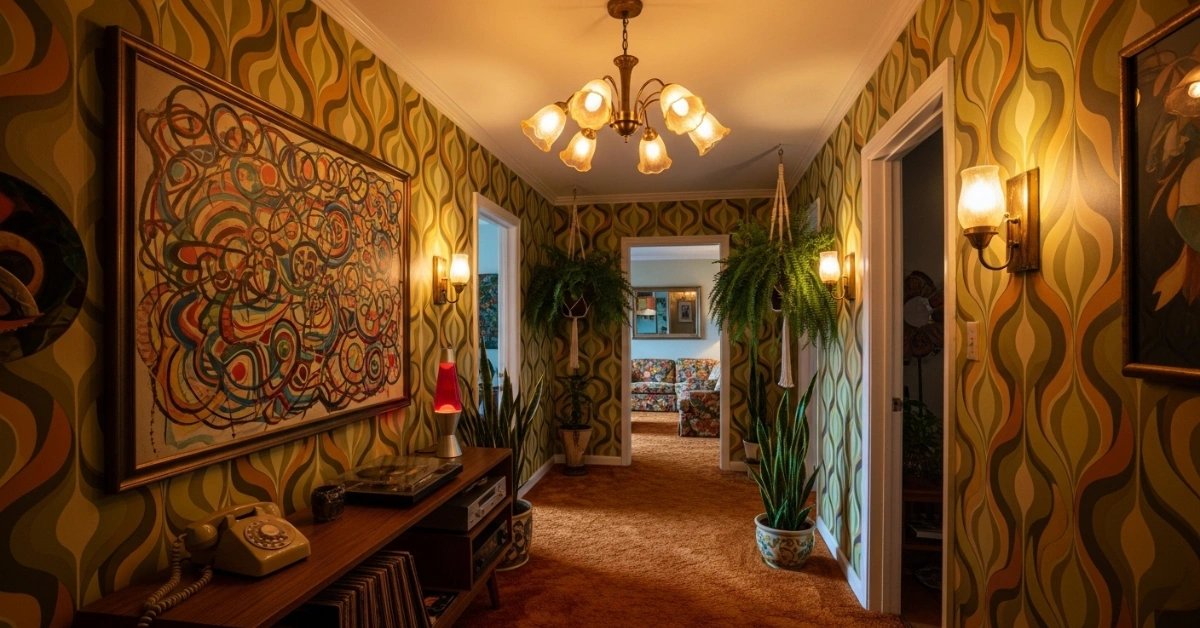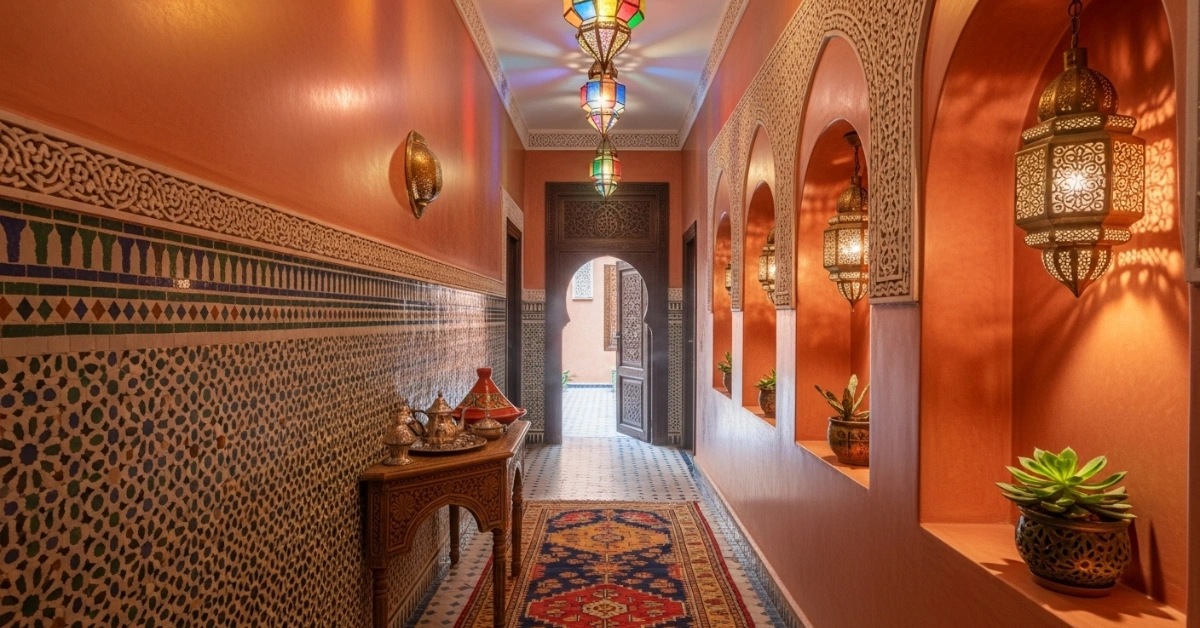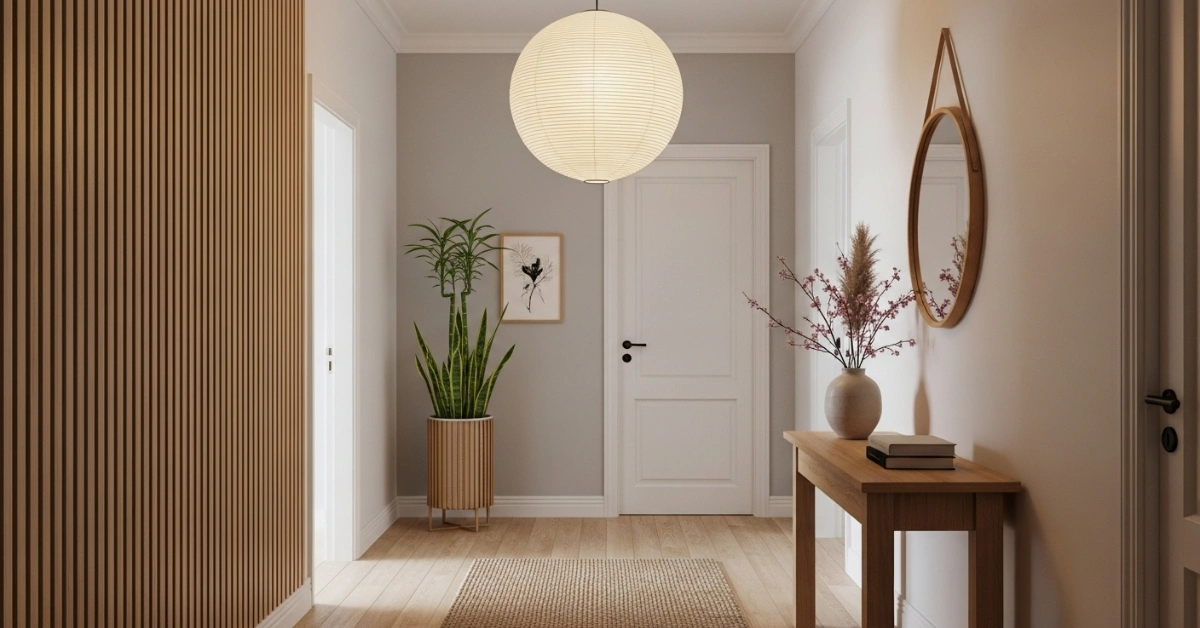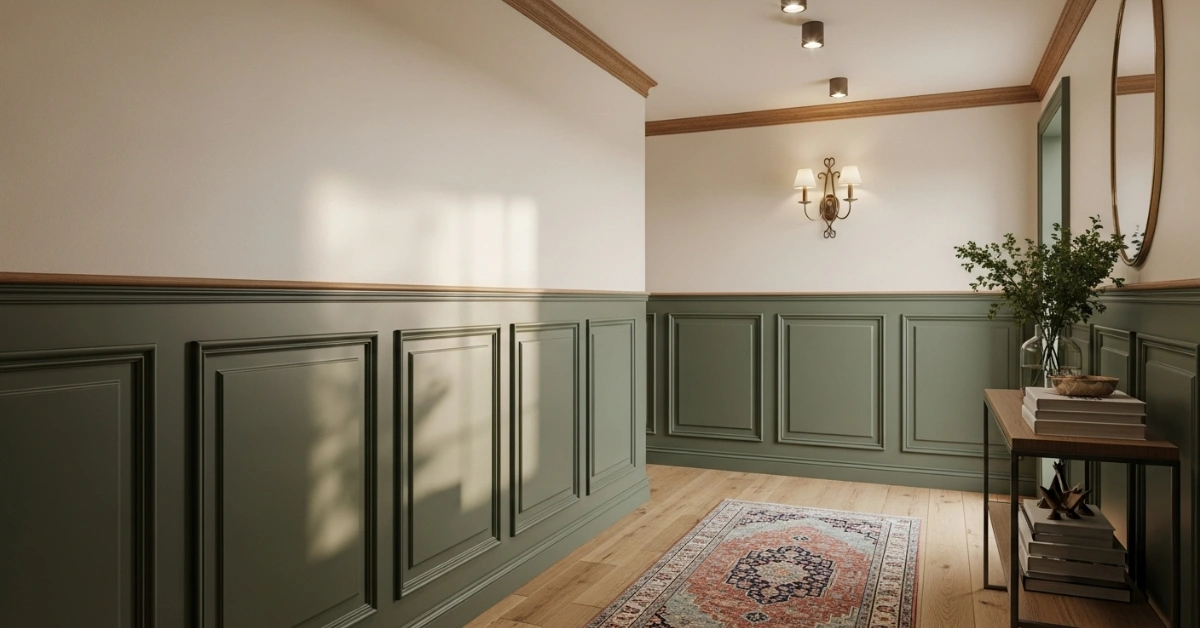1970s Hallway Design: Retro Inspiration for Modern Homes

Walking into a home with a dull, uninspired hallway can feel like stepping into a missed opportunity. Your hallway is the first impression guests have of your space, yet it’s often overlooked, left bland or cluttered. If you’re craving a bold, nostalgic vibe that’s both stylish and timeless, a 1970s hallway design could be the perfect solution. This era’s iconic mix of vibrant colors, funky patterns, and eclectic textures offers endless inspiration to turn your hallway into a standout feature. In this guide, we’ll explore how to recreate the 1970s hallway aesthetic with practical tips, design ideas, and expert insights to help you craft a space that’s both functional and full of personality.
The 1970s were a time of self-expression through design, with homeowners embracing bold choices that reflected individuality. By blending retro elements with modern touches, you can create a 1970s hallway that feels fresh and inviting. Whether you’re starting from scratch or refreshing an existing space, this article will guide you through every step, from color palettes to furniture choices, ensuring your hallway captures the essence of the era while meeting today’s standards.

The Essence of a 1970s Hallway: What Defined the Era
The 1970s hallway was more than just a passageway, it was a statement. This decade was known for its fearless approach to design, blending vibrant colors, geometric patterns, and natural materials. According to design historian Emily Thompson, “The 1970s marked a shift toward individuality in home decor, with hallways becoming a canvas for bold experimentation” (Thompson, Retro Revival, 2020). To recreate this vibe, you need to understand the key elements that defined the era.
Key Characteristics of 1970s Hallway Design
- Bold Colors: Think mustard yellow, avocado green, burnt orange, and deep browns. These hues were often used on walls, rugs, or furniture to create warmth.
- Eclectic Patterns: Geometric shapes, paisley, and floral motifs dominated wallpapers and textiles, adding energy to narrow spaces.
- Natural Materials: Wood paneling, shag rugs, and woven textures brought an organic feel to hallways.
- Funky Lighting: From lava lamps to chrome fixtures, lighting was a focal point, often doubling as art.
- Mix-and-Match Aesthetic: The 1970s embraced combining different styles, like retro with mid-century modern, for a unique look.

These elements came together to create hallways that were welcoming, vibrant, and full of character. By incorporating them thoughtfully, you can evoke the spirit of the decade in your own home.
Choosing the Perfect Color Palette for Your 1970s Hallway
Color is the heart of any 1970s hallway. The era’s palette was warm, earthy, and unapologetically bold, making it ideal for creating a cozy yet striking entryway. Interior designer Sarah Collins suggests, “Use colors that feel grounded but playful—think of pairing mustard yellow with olive green for a true 1970s vibe.” Here’s how to choose and apply the right colors.
Popular 1970s Color Combinations
- Mustard Yellow + Burnt Orange: Creates a warm, inviting glow.
- Avocado Green + Brown: Evokes an earthy, natural feel.
- Teal + Cream: Balances boldness with neutrality for a softer look.
- Red + Gold Accents: Adds a touch of glamour for a dramatic entrance.
Tips for Applying Color
- Paint or Wallpaper One Wall: Use a bold color or patterned wallpaper on a single wall to create a focal point without overwhelming the space.
- Incorporate Accents: Add colorful rugs, artwork, or cushions to bring in pops of 1970s hues.
- Balance with Neutrals: Pair vibrant shades with white or beige to keep the hallway airy and spacious.
- Consider Flooring: Dark wood or patterned tiles in earthy tones can anchor the space.

For example, in a recent project, I saw a narrow hallway transformed with mustard yellow paint on one wall, paired with a cream runner rug and wooden console. The result was a warm, retro vibe that felt modern and welcoming.
Wallpaper and Patterns: Bringing the 1970s Hallway to Life
No 1970s hallway would be complete without bold patterns. Wallpaper was a staple of the era, often featuring geometric shapes, florals, or abstract designs. According to Vintage Home Design (2021), “1970s homeowners used wallpaper to make even the smallest spaces feel dynamic and expressive.”
Choosing the Right Wallpaper
- Geometric Patterns: Triangles, circles, and hexagons in contrasting colors add energy.
- Floral Motifs: Large-scale florals in earthy tones bring a bohemian touch.
- Metallic Accents: Gold or silver details in wallpaper can elevate the look.
- Textured Options: Flocked or embossed wallpapers add depth and tactile appeal.

How to Use Wallpaper Effectively
- Accent Wall: Apply wallpaper to one wall to avoid overwhelming a narrow hallway.
- Ceiling Application: For a bold twist, consider wallpapering the ceiling in a subtle pattern.
- Mix with Paint: Combine wallpaper with painted walls for balance. For instance, a geometric wallpaper paired with avocado green paint creates a cohesive look.
- Small Doses: Use wallpaper in framed panels or as a backdrop for a console table if you’re hesitant about covering entire walls.
Pro Tip: Peel-and-stick wallpapers are a great modern option for renters or those who want flexibility. They’re easy to apply and remove without damaging walls.
Flooring Options for an Authentic 1970s Hallway
Flooring sets the tone for your 1970s hallway, grounding the space in retro charm. The era favored materials that were both practical and stylish, from shag carpets to bold tiles.
Popular 1970s Flooring Choices
| Material | Description | Best For |
|---|---|---|
| Shag Carpet | Soft, plush texture in bold colors | Cozy, warm hallways |
| Patterned Tiles | Geometric or floral ceramic tiles | High-traffic areas |
| Dark Wood | Rich oak or walnut planks | Classic, timeless look |
| Linoleum | Affordable, colorful, and durable | Budget-friendly retro style |

Tips for Choosing Flooring
- Shag Rugs for Warmth: A mustard or orange shag runner adds texture and comfort.
- Bold Tiles for Impact: Hexagonal tiles in green or brown create a striking effect.
- Wood for Versatility: Dark wood floors pair well with colorful walls or rugs.
- Layering: Combine a neutral floor with a patterned runner for a layered look.
In one home I visited, the owners installed a green shag runner over hardwood floors, paired with orange wall accents. The hallway felt cozy yet vibrant, perfectly capturing the 1970s spirit.
Furniture and Decor: Adding Function and Flair
Hallways are often narrow, so furniture in a 1970s hallway needs to be both functional and stylish. The era’s furniture was sleek yet bold, often featuring clean lines and vibrant upholstery.
Must-Have Furniture Pieces
- Console Table: A slim wooden or chrome table for keys, mail, or decor.
- Mirror: A round or arched mirror with a bold frame adds light and style.
- Bench or Stool: A cushioned bench in velvet or leather for seating.
- Wall Shelves: Floating shelves for plants, books, or retro knickknacks.
Decor Ideas
- Plants: Potted ferns or macramé plant hangers add a bohemian touch.
- Artwork: Abstract or pop art prints in bold frames enhance the retro vibe.
- Rugs: A shag or patterned runner ties the space together.
- Vintage Finds: Incorporate flea market treasures like ceramic vases or retro clocks.

Designer Tip: “A 1970s hallway thrives on personality,” says interior designer Mark Evans. “Mix a sleek console with a quirky lamp or bold artwork to capture the era’s eclectic charm.”
Lighting: Setting the Mood in Your 1970s Hallway
Lighting in a 1970s hallway was both functional and decorative, often serving as a statement piece. From funky pendants to sleek sconces, the right lighting can elevate your design.
Popular Lighting Options
- Pendant Lights: Globe or sputnik-style pendants in chrome or brass.
- Wall Sconces: Geometric or art deco-inspired sconces for a retro touch.
- Lava Lamps: A quirky addition for a true 1970s vibe.
- Track Lighting: Sleek and modern, perfect for highlighting artwork.
Lighting Tips
- Layer Your Lighting: Combine overhead lights with wall sconces for depth.
- Choose Warm Bulbs: Opt for warm-toned bulbs to enhance earthy colors.
- Make a Statement: A bold chandelier or pendant can serve as the hallway’s focal point.
- Dimmers for Ambiance: Install dimmable lights to adjust the mood.

For example, a friend recently added a brass sputnik chandelier to their 1970s-inspired hallway, paired with mustard yellow walls. The result was a warm, inviting space that felt straight out of a retro magazine.
Mixing Modern and Retro: Creating a Timeless 1970s Hallway
While the 1970s hallway aesthetic is bold, blending it with modern elements ensures it feels fresh and livable. The key is to balance retro flair with contemporary functionality.
How to Blend Styles
- Neutral Base: Use white or beige walls to tone down bold accents.
- Modern Furniture: Pair a retro rug with a minimalist console table.
- Subtle Patterns: Opt for smaller-scale geometric patterns for a modern twist.
- Smart Storage: Incorporate sleek storage solutions to keep the hallway clutter-free.

Example Design Plan
| Element | Retro Touch | Modern Twist |
|---|---|---|
| Walls | Avocado green wallpaper | White accent wall |
| Flooring | Shag runner | Polished concrete base |
| Furniture | Velvet bench | Sleek metal console |
| Lighting | Sputnik chandelier | LED bulbs for energy efficiency |
This approach creates a 1970s hallway that feels nostalgic yet practical for today’s homes.
Practical Tips for Designing a Functional 1970s Hallway
Hallways are high-traffic areas, so functionality is just as important as style. Here are some practical tips to ensure your 1970s hallway is both beautiful and useful.
- Maximize Storage: Use slim consoles or wall-mounted shelves to keep clutter at bay.
- Add a Mirror: A large mirror makes the space feel bigger and brighter.
- Choose Durable Materials: Opt for washable wallpapers or stain-resistant rugs.
- Keep It Uncluttered: Limit decor to a few statement pieces to avoid a cramped feel.
- Ensure Good Lighting: Adequate lighting prevents the hallway from feeling dark or narrow.

Interior designer Laura Bennett advises, “A 1970s hallway should feel open and inviting. Use bold elements sparingly to maintain balance and functionality.”
Common Mistakes to Avoid in 1970s Hallway Design
While the 1970s aesthetic is fun, it’s easy to go overboard. Here are some pitfalls to avoid:
- Overloading Patterns: Too many patterns can make a small space feel chaotic. Stick to one bold pattern and balance with solids.
- Ignoring Scale: Oversized furniture can overwhelm a narrow hallway. Choose slim, functional pieces.
- Poor Lighting Choices: Dark hallways feel unwelcoming. Ensure ample lighting to highlight retro elements.
- Neglecting Flow: Ensure the hallway’s design complements adjacent rooms for a cohesive look.
By keeping these in mind, you can create a 1970s hallway that’s stylish and practical.
Inspiration Gallery: Real-Life 1970s Hallway Ideas
To spark your creativity, here are three real-world-inspired 1970s hallway designs:
- Bohemian Bliss: A hallway with mustard yellow walls, a shag runner, and macramé plant hangers. A round mirror and brass sconces add warmth.
- Retro Glam: Burnt orange wallpaper paired with a chrome console and a sputnik chandelier. A velvet bench adds a luxurious touch.
- Earthy Elegance: Dark wood floors, avocado green paint, and a geometric rug. Framed pop art prints tie the look together.

These examples show how versatile the 1970s hallway aesthetic can be, offering something for every taste.
Conclusion
A 1970s hallway is more than just a passageway, it’s a chance to make a bold statement and infuse your home with personality. By blending vibrant colors, funky patterns, and retro-inspired furniture, you can create a space that’s both nostalgic and timeless. Whether you’re drawn to the earthy tones of avocado green or the playful energy of geometric wallpaper, the key is to balance bold choices with modern functionality. Start small with a shag rug or a statement light fixture, and let your creativity shine.
Ready to transform your hallway into a retro masterpiece? Begin by choosing one or two 1970s-inspired elements, like a bold color or patterned wallpaper, and build from there. Share your design journey in the comments below, or contact a local interior designer to bring your 1970s hallway vision to life!






